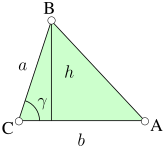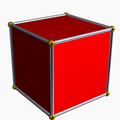In geometry, an edge is a particular type of line segment joining two vertices in a polygon, polyhedron, or higher-dimensional polytope.[1] In a polygon, an edge is a line segment on the boundary,[2] and is often called a side. In a polyhedron or more generally a polytope, an edge is a line segment where two faces meet.[3] A segment joining two vertices while passing through the interior or exterior is not an edge but instead is called a diagonal.

Three edges AB, BC, and CA, each between two vertices of a triangle. |
 A polygon is bounded by edges; this square has 4 edges. |
 Every edge is shared by two faces in a polyhedron, like this cube. |
 Every edge is shared by three or more faces in a 4-polytope, as seen in this projection of a tesseract. |
Relation to edges in graphs
In graph theory, an edge is an abstract object connecting two graph vertices, unlike polygon and polyhedron edges which have a concrete geometric representation as a line segment. However, any polyhedron can be represented by its skeleton or edge-skeleton, a graph whose vertices are the geometric vertices of the polyhedron and whose edges correspond to the geometric edges.[4] Conversely, the graphs that are skeletons of three-dimensional polyhedra can be characterized by Steinitz's theorem as being exactly the 3-vertex-connected planar graphs.[5]
Number of edges in a polyhedron
Any convex polyhedron's surface has Euler characteristic
V-E+F=2,
where V is the number of vertices, E is the number of edges, and F is the number of faces. This equation is known as Euler's polyhedron formula. Thus the number of edges is 2 less than the sum of the numbers of vertices and faces. For example, a cube has 8 vertices and 6 faces, and hence 12 edges.
Incidences with other faces
In a polygon, two edges meet at each vertex; more generally, by Balinski's theorem, at least d edges meet at every vertex of a d-dimensional convex polytope.[6] Similarly, in a polyhedron, exactly two two-dimensional faces meet at every edge,[7] while in higher dimensional polytopes three or more two-dimensional faces meet at every edge.
Alternative terminology
In the theory of high-dimensional convex polytopes, a facet or side of a d-dimensional polytope is one of its (d − 1)-dimensional features, a ridge is a (d − 2)-dimensional feature, and a peak is a (d − 3)-dimensional feature. Thus, the edges of a polygon are its facets, the edges of a 3-dimensional convex polyhedron are its ridges, and the edges of a 4-dimensional polytope are its peaks.[8]
See also
Extended side
References
Ziegler, Günter M. (1995), Lectures on Polytopes, Graduate Texts in Mathematics, 152, Springer, Definition 2.1, p. 51.
Weisstein, Eric W. "Polygon Edge." From MathWorld--A Wolfram Web Resource. http://mathworld.wolfram.com/PolygonEdge.html
Weisstein, Eric W. "Polytope Edge." From MathWorld--A Wolfram Web Resource. http://mathworld.wolfram.com/PolytopeEdge.html
Senechal, Marjorie (2013), Shaping Space: Exploring Polyhedra in Nature, Art, and the Geometrical Imagination, Springer, p. 81, ISBN 9780387927145.
Pisanski, Tomaž; Randić, Milan (2000), "Bridges between geometry and graph theory", in Gorini, Catherine A. (ed.), Geometry at work, MAA Notes, 53, Washington, DC: Math. Assoc. America, pp. 174–194, MR 1782654. See in particular Theorem 3, p. 176.
Balinski, M. L. (1961), "On the graph structure of convex polyhedra in n-space", Pacific Journal of Mathematics, 11 (2): 431–434, doi:10.2140/pjm.1961.11.431, MR 0126765.
Wenninger, Magnus J. (1974), Polyhedron Models, Cambridge University Press, p. 1, ISBN 9780521098595.
Seidel, Raimund (1986), "Constructing higher-dimensional convex hulls at logarithmic cost per face", Proceedings of the Eighteenth Annual ACM Symposium on Theory of Computing (STOC '86), pp. 404–413, doi:10.1145/12130.12172.
External links
Weisstein, Eric W. "Polygonal edge". MathWorld.
Weisstein, Eric W. "Polyhedral edge". MathWorld.
Undergraduate Texts in Mathematics
Graduate Studies in Mathematics
Hellenica World - Scientific Library
Retrieved from "http://en.wikipedia.org/"
All text is available under the terms of the GNU Free Documentation License

